If you purchase an independently reviewed item through our site, we earn an affiliate commission. Read our affiliate disclosure.
The Langstroth beehive is perhaps the most popular beehive used in beekeeping all over the world – and for good reason too. It has features that make it great for both small and large beekeeping operations. This beehive type allows for harvesting of various beehive products in large quantities that make beekeeping profitable. It also allows for easy management of honeybee colonies. Other popular types of beehives are the Top-bar hive and the Warré hive (check out our article on the comparison of these beehives). This beginner’s guide to the Langstroth beehive highlight its features, advantages, disadvantages, and just what exactly makes it so popular.
History of the Langstroth Beehive
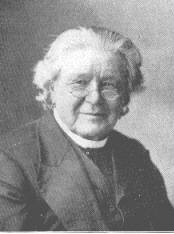
The Langstroth beehive was invented in 1852 by Reverend L.L. Langstroth. Langstroth was a native of the state of Pennsylvania, living in the city of Philadelphia. This beehive has changed a little over the years to its current modern design. However, despite the changes, modern Langstroth beehives still makes use of the principles of the original design. The Langstroth beehive was designed to be expandable and modular, while providing very convenient access for beekeepers. They make use of vertically hanging frames, on which the honeybees build comb. This was a key innovation in the invention of the Langstroth beehive. The design of a Langstroth beehive is standardized across the world and allows beekeepers to use parts from different manufacturers.
Inspiration
Before the Langstroth beehive came about, beekeepers used log hives and skeps. A skep is a conical straw basket. Box hives were also used by some beekeepers. In 1851, Langstroth noticed that bees would not build comb in any space measuring between 9 and 6 mm. Langstroth did not give a name for this space. It was later called bee space. They use this space for movement through the beehive. They do not seal it shut with propolis. Langstroth applied the concept of his beehive and kept the lid free on a top bar hive in 1851 in the summer. In autumn, he realized that the bee space concept could be applied to a frame design that prevented bees from drawing honeycomb on the inner surfaces of a beehive box.
Invention
On October 25th, 1852, Langstroth was issued with US Patent number 9300. He had solved the problem of attachment of comb to beehive boxes successfully. The patent was challenged numerous times on the claims that Langstroth made use of previous art. It was however not taken back and remained valid. In his lifetime, Langstroth made more discoveries in beekeeping and is a major contributor to the modern beekeeping industry. The Langstroth beehive is practical and makes use of removable frames. It is expandable vertically by placement of additional beehive boxes. In a Langstroth beehive, the brood is in the lower beehive boxes while honey is stored in the upper boxes. It is top-opened unlike other beehives of the time. The combination of great features made the Langstroth beehive quickly adapted in beekeeping throughout the world.
Original Design
In his original design, Reverend L.L. Langstroth used a portico entrance to the Langstroth beehive. The beehive had an integrated floor and featured a fixed brood box with a single removable honey super box. The removable honey super box made use of the same frame size as the fixed brood box. This honey super box sat in an outer box that extended upwards from the brood box. The beehive had a hinged roof to cover everything and shelter bees. Langstroth made his beehive in a construction that allowed frames to be easily separated. The frames on which bees build honeycomb were also free from all adjacent beehive parts such as the walls and floor of the hive. This separation also extended to the cover of the beehive.
Legacy
To document his invention and discoveries in beekeeping, Langstroth published a book. He titled it A Practical Treatise on the Hive and Honey-bee. Today, the book is known as The Hive and the Honey Bee. It was re-issued in 2004 under the title Langstroth’s Hive and the Honey-Bee: The Classic Beekeeper’s Manual. In the book, Langstroth details the exact dimensions of his beehive. These are seen in use to date in modern Langstroth beehives. The book that Langstroth wrote has undergone a number of revisions and is available in many editions. In all editions and releases of Langstroth’s book, the beehive that he described and illustrated is retained in its original design.
Key Features of the Langstroth Beehive
Langstroth beehives are typically designed in a bottom up or top-down design format. Indeed, it is its construction that makes it so successful and accepted worldwide by beekeepers. Its key features make it very suitable for bees, beekeeping and for the harvesting of beehive products. This beehive has the highest success and survival rate for bees through all the seasons including winter. A Langstroth beehive is expandable by the addition of beehive boxes at the top. It also allows for interchangeability. This is because of its standard size which allows parts from different manufacturers to fit in the beehive and work well. The dimensions of each component in a Langstroth beehive are standard and well defined.
8 and 10-frame setups
The standard Langstroth beehive stack can be in any of two sizes: 8-frame and 10-frame. They give the best value for space. (Of course, some modern manufacturers have modified the original design with their inventions to create beehives which hold 6 or even 7 frames.) These two setups have varying suitability of use based on the climate of a region and the preferences of individual beekeepers. Countries where winters are severe are best served by the 8-frame setup. It allows easier vertical movement of bees in winter. The 10-frame setup is great for areas where winters are not severe. It allows for increased production in both brood and honey storage. You also get more yields of beeswax with the 10-frame setup.
Aesthetics
Langstroth beehives are popular due to their aesthetics too. They are not unsightly and can even left in their natural wood color when some types of wood are used to make them. Western red cedar show their wood grain very well and do not require painting over. Pine wood painted in light colors are also very beautiful to look at.
Ease and cost of assembly
In addition to this is the minimal cost of assembling or building a Langstroth beehive. For tight budgets, pine beehives are the way to go. An average Langstroth beehive is economically priced. Beekeepers have a wide array of choices from competitive manufacturers of Langstroth beehives and their components. The rise of plastic components has also helped drive the price of these beehives and their accessories down.
Location of entrance
The lower end of the Langstroth beehive is where bees enter the beehive. It allows bees to access the brood first and then the stored honey. Bees living in such a setup show better health and make strong honeybee colonies. The colonies are easy to manage and the brood is not disturbed when you are harvesting honey. The bottom board of a Langstroth beehive is an important feature of the beehive at the lower end. It covers the bottom of the beehive stack and can be fitted with entrance reducers to improve among others hive security.
Availability of space
A Langstroth beehive boasts excellent use of available space. Frames in the beehive are separated to just allow bees movement between them. The ability to separate brood from honey storage also gives clean honey without eggs or bee brood in it. A Langstroth beehive allows easy management of bees as well as harvesting of beehive products. It makes the exercise of beekeeping safer for both honeybees and the beekeeper. Having movable frames helps beekeepers to do things that are not possible with other types of hives. A failing colony can be assisted with a few frames of honey from a stronger colony. In the event that a queen bee is failing, you can bring in brood frames from another beehive and have the worker bees bring up a new queen bee.
Durability
Langstroth beehives are very long-lasting. They are made in a design that allows destructive elements to run off the beehives. Use of strong and durable wood types increases the durability. Popular wood types such as pine and cedar are friendly to bees while being easy to preserve. A coat of waterproof paint on the outer surfaces of a Langstroth beehive does the job of protecting the wood very well. Other preservation methods that are not harmful to bees and which do not make the beehive unwelcoming to bees can also be used. When painting a Langstroth beehive, a light color is used on the outside to keep the beehive cool in the warm months.
Ease of use
Beekeepers have a very easy time working with Langstroth beehives. They are not very heavy to handle during beehive inspections and even when a box is full with honey-laden beehive frames. An 8-frame or 10-frame beehive box is easy to lift and move. Beekeepers may remove frames from a box and replace them with empty frames when harvesting honey. The beekeeper only handles one beehive box at a time in a Langstroth beehive setup – not the entire beehive at a go. Wood used in constructing your Langstroth beehive is also an important factor when considering weight. Light wood such as western red cedar is great. It gives excellent weight reduction per beehive box and is naturally resistant to most destructive elements of wood.
Components of the Langstroth Beehive
A Langstroth beehive is made up of many components and parts. They work together to make sure the beehive is a suitable home for honeybees. Each component is important and serves a specific purpose. The parts and components can be divided into two main categories. These are the main components and specialty parts. Here is a detailed look at the various parts and components. We will start with the main components and then look at specialty ones.
Hive bodies/boxes
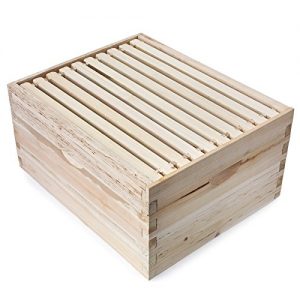
In a Langstroth beehive, honeybees are housed in beehive boxes. There are two sizes of Langstroth beehive boxes based on their width. These are 10-frame and 8-frame beehive boxes. The boxes in a Langstroth beehive stack should all be of the same size so that no gaps are left between them. You cannot use a mix of 8-frame and 10-frame beehive boxes. Based on depth, there are three sizes of beehive boxes: shallow, medium and deep boxes. The deep boxes are often used for brood while shallow and medium boxes are great for honey storage. Beehive boxes hold frames inside them. Honeybees draw comb on the frames and use them to rear brood and store honey.
Brood boxes are found in the lower end of a Langstroth beehive. On top of the brood boxes are the honey super boxes. Using this arrangement allows a Langstroth beehive to have as much space as the beekeeper wants their honeybees to have. More brood boxes mean more bees in the colony while more honey super boxes give higher honey yields. Each hive box contains frames on which bees draw honeycomb. The frames are made to exact dimensions and can be fitted with foundation to start bees drawing comb and guide them to draw comb on a specific plane.
Frames

Every beehive box in a Langstroth beehive requires frames. Honeybees use the frames to hold their honeycomb. The size of Langstroth beehive frames is uniform in length and width. They vary in their depth. The beehive frame must be suitable for the depth of the box it is used in. As a result, frames for deep beehive boxes have the biggest depth while those for shallow boxes have the smallest depth. You can have frames in sets of 10 or 8 depending on whether your beehive box is 8-frame or 10-frame. Frames can be used with or without foundation. They may be made of wood or plastic as seen in some beekeeping operations. There are also specialty frames called flow frames. We will discuss these flow frames in the section for specialty components of Langstroth beehives.
Telescoping cover
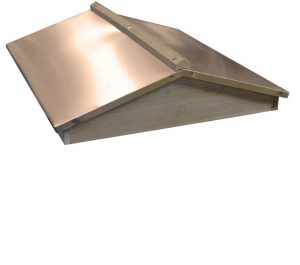
A telescoping cover for Langstroth beehives is also called the top cover. It goes on top of everything in the Langstroth beehive. This cover protects the beehive from direct sunshine and the other elements such as rain or snow. The telescoping design of the cover overlaps the inner cover and extends beyond the uppermost beehive box. It then hangs down over the edges of the beehive to keep water from rain and melting snow from dripping into the beehive. Some beekeepers prefer their outer cover to be slanted for better drainage of water from the top of the beehive. Beekeepers who have sheltered their beehives using some other means use a migratory cover that does not telescope down the sides of their Langstroth beehives. This also works for indoor beekeepers.
Inner cover
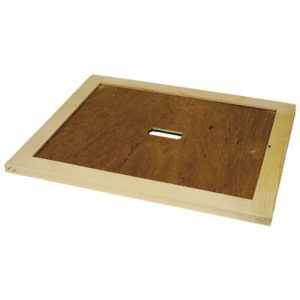
The inner cover of the Langstroth beehive has two important functions. It provides a layer of protection to honeybees and prevents bees from building comb between the top cover and the uppermost beehive box. The inner cover can be made in various designs that may allow for space between the top honey super box and the surfaces of the top cover. Bees are likely to build comb or use propolis in such a space when it is present. The inner cover keeps the bees from accessing this space.
The inner cover is placed on top of the uppermost box in the stack. It may have a small gap to give bees an upper entrance. Such an entrance allows bees to access the honey super boxes without having to go through the brood boxes. It helps reduce crowding and swarming in honeybees. Feeders can also be placed on top of an inner cover that has this gap. When feeding bees above the top cover, place the feeder on the top cover and then place an empty beehive box over the feeder. You should then have a second inner cover over this uppermost beehive box encompassing the feeder.
Bottom board
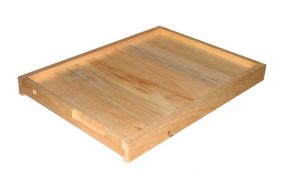
The bottom board provides an entrance for honeybees . It also supports the beehive stack on top of it. Directly above the bottom board is the first brood box of the beehive. A bottom board can be modified in its entrances and can be screened. Beekeepers can also place devices such as pollen traps on the bottom board to carry out specific functions. The bottom board is the bottom-most part of a Langstroth beehive. It sits on a stand or other supporting structure you use to raise the beehive off the ground.
Specialty Components for the Langstroth Beehive
Hive stand

A Langstroth beehive should be placed on a hive stand, as it elevates the beehive off the ground. This helps prevent predators from easily reaching the beehive. Due to its ability to come apart easily, a Langstroth beehive under a large predator attack is easily destroyed. The stand used can be made using any suitable material. The stand also helps preserve the beehive by keeping it dry. A beehive in contact with the ground rots easily and can be damaged by termites.
Entrance reducer
An entrance reducer in a Langstroth beehive is important for a number of reasons. It helps with beehive security when your bees have less entrance space to guard. Entrance reduction also assists with pest and parasite control. Varroa mites are brushed off the bee when it goes through a reduced entrance. The size of the entrance to use depends on the weather, the size of the honeybee colony and the preferences of individual beekeepers.
Screened bottom board

In hot climates, screened bottom boards help with beehive temperature regulation. They are also useful in controlling some pests and parasites of honeybees. Screened bottom boards allow debris to fall through thus helping with beehive hygiene. A screened bottom board cannot be used by bees or their predators as an entrance.
Queen excluder
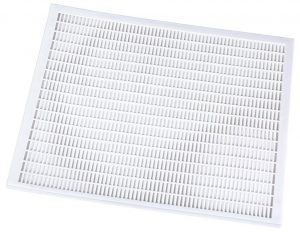
Stored honey in super boxes is harvested by beekeepers. They do not want eggs or brood in these boxes. A queen excluder keeps the queen bee restricted to brood boxes only. This prevents contamination of honey with bee eggs and brood. A queen excluder should be of a suitable size so that it does not allow the queen be to go through it, while not impeding the movement of worker bees throughout the hive. The queen excluder is placed between the uppermost brood box and the lowest honey super box.
Bee feeder

Honeybees may require assistive feeding in some seasons. This is also necessary when you have newly installed bees in a Langstroth beehive. A bee feeder is filled with sugar syrup and helps the beekeeper ensure better survival chances for the honeybees.
Foundation
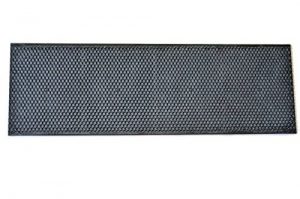
Foundation on beehive frames is used in Langstroth beehives to guide bees on where they will build honeycomb. For wooden beehive frames, foundation can be plastic or wax. For plastic beehive frames, the foundation used is always made of plastic. The use of foundation is not favored by some beekeepers for various reasons, resulting in the great foundation vs foundationless beekeeping debate.
Flow frames

Flow frames are a modern innovation in beekeeping that allows harvesting of honey without removing the frames from the beehive. Using flow frames also avoids having to open up the beehive when harvesting honey. Langstroth beehives with flow frames often have observation windows which also make beehive inspections easy on bees and the beekeeper. Flow frames make use of accessories such as flow keys and collecting tubes. They are used when harvesting honey from these frames. Plastic is the main material used to make flow frames. Some metal is also used to add strength to the frames.
Pros and Cons of the Langstroth Beehive
The popularity of Langstroth beehives in beekeeping is due to its advantages. It is also easily modified to suit the individual preferences of beekeepers. There are also innovations on the Langstroth beehive that continue to endear it to beekeepers and make it more suitable for beekeeping operations.
Pros
Bee friendly
Langstroth beehives are friendly to bees and their natural life cycles. The layout allows for further separation of the brood from stored honey. This allows for better wintering of bees. In a Langstroth beehive, heat conservation is easier to achieve, which provides a better chance for honeybees get through winter with lower losses in their numbers. Bees can move through the box easily as they exhaust the stored honey in winter. As a result, the honeybee colony reaches spring with excellent colony strength.
Space
Space is not a problem with Langstroth beehives. It is easy to add beehive boxes for more brood and honey storage space. This gives beekeepers colonies that are strong in their numbers and high yields of honey to harvest. The foraging power of a large colony of honeybees is better. A Langstroth beehive is expandable upwards and can be used with a queen excluder without affecting the health of the honeybee colony.
Hive security
Large colonies that beekeepers rear with Langstroth beehives are better at beehive defense. Insect predators of honeybees are easier to deal with when your honeybee colony has enough worker bees. Predators that are easily overwhelmed when there are enough worker bees for the job includes yellow jacket hornets and robber bees. In addition to accommodating large number of bees, Langstroth beehives have reducible entrances. Using an entrance reducer when bees are not active or with small honeybee colonies helps improve hive security.
Ease of honey harvesting
When it is time to harvest honey, the ease with which you get through the exercise is important. A Langstroth beehive makes harvesting of honey very easy. You can remove frames easily from beehive boxes and replace them with fresh frames. Once you have extracted honey from the beehive frames, returning them to the beehive is not a difficult task. Langstroth beehive frames can be extracted and the honeycomb left intact, or the honeycomb removed so you can have some beeswax as a beehive product.
Use of foundation
Foundation in beekeeping gives honeybees a head start in everything. A colony supplied with foundation frames starts rearing brood and storing honey immediately. Extracted Langstroth beehive frames whose honeycomb is left intact saves bees the need to draw wax afresh on the frames. This allows more honey to be stored by each honeybee colony you have in your apiary. For every pound of wax made in the beehive, there is a loss of more than 2 pounds of honey. The savings in honey translate to higher yields for the beekeeper when you harvest honey from the beehive.
Use of a queen excluder
By allowing easy use of a queen excluder and alternative entrances, a Langstroth beehive gives you clean honey. This is in respect to the presence of bee eggs and larvae in harvested honey. With a properly functioning queen excluder in a Langstroth beehive, your honey is free of eggs and bee larvae. You can sell the honey extracted and packaged or as comb-honey. Harvesting honey from a Langstroth beehive does not require mashing. It is done using extractors and strainers. This allows frames to be put back to use quickly, and gives very clean honey free of impurities.
Keeps honeycomb intact
To extract a beehive frame from a Langstroth beehive, you do not need to cut through any honeycomb. The frame is removed by pulling it vertically from the beehive box. The biggest problem beekeepers may encounter with frame extraction is honeybees binding a frame to the bracket it rests upon using propolis. The ability to remove and replace frames easily makes it practical and possible for beekeepers to inspect beehives and the honeybee colonies in them regularly. In a beehive inspection, you check for signs of imminent swarming, diseases, parasites of honeybees, queen presence and honey storage. A beekeeper on an inspection decides if intervention is necessary. A beehive inspection is one of the most important activities for successful beekeeping.
Cons
Too heavy
The weight of Langstroth beehive boxes can be a problem for some beekeepers. Aged beekeepers cannot easily work with Langstroth beehive boxes when they are full of honey or brood. Even young beekeepers risk strains and other injuries as they lift the boxes in the upper sections of a Langstroth beehive stack. A workaround for this challenge with Langstroth beehive boxes is using light wood to build the boxes and working with 8-frame setups in place of 10-frames.
Added costs
It is sometimes expensive for beekeepers buying equipment to work with Langstroth beehives. Compared to other types of beehives, a Langstroth beehive requires extractors for when you are harvesting honey and other specialized equipment for general beekeeping practices. The cost of buying and maintaining this equipment is in addition to the investments you make in beekeeping and may turn prohibitive to low-budget beekeepers.
Frequent exposure
Inspecting Langstroth beehives leads to opening up the entire beehive. Even when this is done box by box, you risk exposing brood to cold. Additionally, honeybees may get excessively agitated due to the intrusion.
Conclusion
Beekeeping can be done using various beehives. The beekeeper must research about the various beehives available and decide the best for his/her beekeeping operation. The Langstroth beehive is a very useful for beekeeping with an aim for profits. It has numerous advantages over other types of beehives. This has led to it being very popular in beekeeping. It is the best to use even for conservationist beekeepers. Use this beginner’s introduction to the Langstroth beehive to gain better understanding of your beehive and how to use it in your beekeeping operation.
What are your thoughts on this article? Leave a comment below and let us know.
 BeeKeepClub Resources and Guides for Beekeepers
BeeKeepClub Resources and Guides for Beekeepers

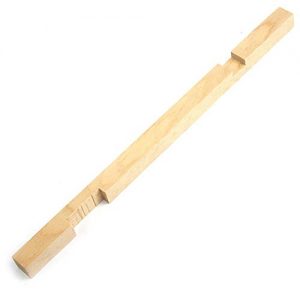
Great explanation of hive. Great article
Thank you!
This is an excellent article
Thank you!
[…] one that has been much hyped of late. Other popular choices among beekeepers include the Warre, Langstroth, British National, Top Bar hive, WBC hive, and many […]
[…] The list of models you are about to peruse below is exclusive. For now, they are the best you can think of in the industry. Go through each of them and discover the model that is suitable for your needs. They are all durable and will serve you for a long time. They are simple yet function effectively. These queen excluders are designed to work with Langstroth beehives. […]